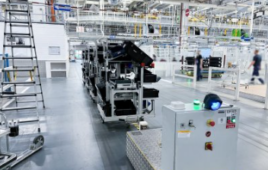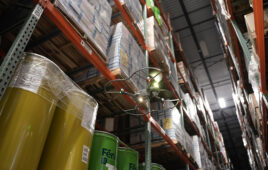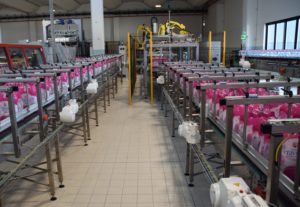
Parallel bottling lines.
To satisfy the demand for higher productivity and energy efficiency, Sacmi Filling chose the Danfoss VLT FlexConcept drive system to manage new bottling lines designed and installed at the new headquarters of the Brescian company, Fonte Tavina. This system has added value thanks to its almost non-existent use of sensors and photocells, thus guaranteeing long-lasting services.
Over 100,000 bottles per hour, equivalent to a potential of 400 million per year, distributed in 25 countries, from Belgium to Russia, from the United States to Australia, from New Zealand to Japan, and from China to Kuwait — This is Tavina, a bottling company for four mineral waters, Tavina, Linda, Allegra, and Novella, who made automation 4.0 their own in a new plant in Salo (BS).
The water that flows from the glacial basin of the Lombardy foothills, inside the Natural Park of Alto Garda, then flows into a highly automated process. It is put into bottles (PET or glass), which are molded, labeled, packaged, and stored in an automated warehouse ready to be dispatched all over the world. The two new automatic bottling lines are PET leaders.

HMI for transporter automation where Sacmi replicated the LCP programming of the
frequency converters to potentially modify the parameters of each device without needing to open the electrical cabinet.
Key to these results was the use of the Danfoss VLT AutomationDrive FC 302 and the high-efficiency VLT OneGearDrives installed at the end of the line. Sacmi Filling technicians have used the technological combination, known as the VLT FlexConcept, to the best of its abilities for the planned objectives.
“This project has a challenging objective,” said Giorgio Frosi, Sacmi Filling Beverage Engineering Department. “We aim to meet the strict requirements for productivity and processing speed, as well as energy efficiency so that we can be the most competitive over time.”
“There are two twin bottling lines — explained Frosi — and they are interchangeable. One is for the production of 0.5 L bottles, and the other is for 1.5 L bottles.”
The journey begins with the initial separate sourcing of caps and preforms, which then flow into the blower (that transforms the preforms into bottles), and finally, go to the filler and capping machine. The next step involves the labeling of every single bottle before proceeding to the transport system. At this point, there is a split along a buffer.
“Once the bottles have left the labeling machine — continued Frosi — they are sorted into alternate groups down two contiguous channels. These flows are then spaced out and distributed onto various pathways, where the bottles are ready to be put into bundles for final packaging.”
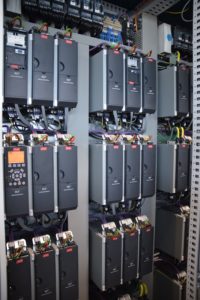
The Danfoss VLT AutomationDrives, with suitable dimensions for the transporter type’s requirements installed on the cabinet, are designed to control the variable speed of all permanent magnet synchronous reluctance motors. They are made to increase flexibility and optimize process control for any industrial machine or production line.
By following the path of the bottles, the other 40 VLT OneGearDrives (per line) meet. The highly efficient permanent magnet and three-phase synchronous motors, (equal to 96%, superior to the IE4 standard), combine with optimized bevel gearboxes to help improve plant productivity and reduce energy costs.
“With only one motor type and three available gear ratios available,” explained Fabio Galletti, Sales Account Manager Danfoss Drives, and Emilia Romagna, Sacmi Filling client administrator, “this product covers all typical versions of conveyor drives commonly used in the food and beverage industry.”
The reduced range of the physical configurations for these drives slashes costs and simplifies spare-part storage. Uniform mechanical dimensions reduce engineering and installation time and costs. The drive comes in two versions: Standard for dry and humid production areas (like the Fonte Tavina case), hygienic for humid and aseptic environments that require intense cleansing and sterile production areas.
“Furthermore,” added Galletti, “the design that characterizes these gear motors allows them to be joined, head to head, without mechanical interference, as their diameter is only 76 mm and they are reversible.”
Again, each line is equipped with 40 VLT OneGearDrives positioned along the transport system. Likewise, these correspond to the Danfoss VLT AutomationDrives, which are suitably positioned in the automation cabinet. They were designed for variable speed control of all asynchronous motors and permanent magnet motors, both with closed and open-loop (the latter have been chosen and adopted by Sacmi Filling specifically for this application). This design increases flexibility and optimizes the control of processes on any industrial machine or production line.
The robust structure guarantees maximum functioning time. The items are also fitted with a large range of the sector’s standard characteristics, which can be expanded with other “plug-and-play” options. The user-friendly and quick-use graphical control panel ensures the drive is easy to set up and operate, also saving commissioning and operating costs. These drives are used in Tavina, not just for the transport system, in combination with gear motors, but also to optimize the control of the process of various machines in the line. For example, on the blower, in the filler, on the mixer, for the labeling machine, and, partially, on the palletizers, where there are no axis controls.
The sensorless system, used by the Sacmi Filling technical team can manage almost all bottling lines without using control sensors or photocells, and can be used in a conventional manner for these applications.
“The application of the sensorless system,” added Frosi, “was made possible thanks to the accurate and timely feedback from the VLT OneGearDrive permanent magnet motors, concerning current absorption and torque. This information, interpolated from our control algorithm, based on the calculation of the current and torque that the motor is absorbing in certain conditions, allows for optimized process management by facilitating maximum productivity. The information also facilitated the layout during the device design phase.”
Moreover, the system, for example, is authorized to control the entrance of the bottles into the shrink wrapper in a limited space of no more than three linear meters. Normally, it would be necessary to have almost triple this distance for the bottles to be fed in a correct, homogeneous, and balanced process.
Distributed, constant and continuous performance
“It was certainly a huge challenge t to compress the layout in this manner, without a sensor or photocell to restore information required for the process, such as the number of containers at that line section,” underlined Frosi.
The operational approach is carried out both on the transport section of the unpackaged bottles and on the entire conveyor section of the packages that are ready. The evolved automation system that Sacmi Filling was able to implement, thanks to the VLT FlexConcept drive system, not only avoided the direct use of sensors and related wiring but provided even more significant added value.
“The sensorless system” — observed Frosi — “guarantees services that are equivalent, if not superior, to those obtained by managing flows in a more conventional manner, using sensors and photocells.
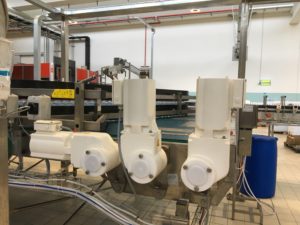
View of the Danfoss VLT One Gear Drives, installed at the end of the line. IP 69K protection level fulfills requirements for the best hygiene and cleansing design.
As there had been requirements for a field inverter rather than a panel inverter at the end of the line, the Danfoss team provided the VLT Decentral Drive FCD 302 frequency converters to be positioned near the motor, eliminating the need for long cables.
“This option,” explained Galletti, “does not require any change to control and management communications. This means the system is modular and will remain so for future operational integrations or new devices. It always maintains its global output (Drive + motor + gearbox) that is greater than 89%.”
Key automation 4.0
Sacmi Filling technicians also used other drives on these bottling lines, namely the VLT Micro Drive FC 51, for the final part of the line, the palletization. At this stage, the wrapped bottle packages then go to shuttles, in a fully automated manner, are conveyed by the pallet to the storage warehouse (20-m high and able to store 11 thousand pallets), and are ready to be dispatched.
“This process,” concluded Forsi, “is in line with the specifics of Industry 4.0 and it can be managed and controlled via tablet and PC at all phases, for which progressive controls are planned. Any bottle that does not conform can be detected and removed without interrupting the cycle and, therefore, productivity.”
Today, this productivity amounts to over 200 million bottles per year (80% produced by the plastic lines), a number that could be doubled at this rate. These numbers, along with the energy savings generated by new devices amounting to no less than 20%, are significant and are obtained thanks to the technologies used. These figures are required to ensure that Fonte Tavina remains a competitive mineral water producer and distributor.
Danfoss
danfoss.com/en-us/
Filed Under: AUTOMATION



